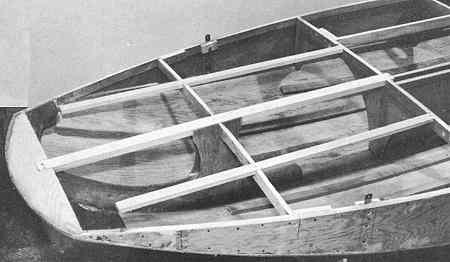
WebLetter 20
An Occasional Publication for the Home Boat Builder
Glen-L Marine Designs - 9152 Rosecrans Ave. - Bellflower, CA 90706
In this issue
- Pontoon vs Barge
- My Father and a Glen-L Rebel
- Rigging Small Sailboats - Chapter 7
- Performance Report: Tunnel Mite
-
What are your
experiences
Boat registration, cost to build.... - Shop talk: Centerboard trunk
- Salt water and wood
- Recent email
Glen-L Update
-
Website:
- There have been a lot of subtle changes to the site (colors and layouts).
- Glen-L Boatbuilder caps and T-shirts page added (see below).
- We have added a "Notes" page on several designs in the Boat Design Catalog. These were in answer to specific questions. In the future we hope to add more.
- We have added a "Skid fin" to the Small Boat Steering page in "Supplies", again in answer to inquiries.
- We have also added notes to several items on the Inboard Hardware pages.
- We have taken the Pedal-It out and put it through its paces at a 4th of July picnic. Lots of food, quite a workout for the boat. We found a few things we want to change, but these will have to wait as the shop is tied up making frame kits. To see pictures of the "pond trials", see the New pages/on the Drawing Board.
- There are several small photos in this WebLetter with a blue line around them... they are "hot". Click on them to see a larger photo.
-
Share What You Know with Other Builders:
The readers of this WebLetter make up a community of individuals with practical experience in the joys and pitfalls of boat building. You are a member of that community and have something to contribute. Please share your knowledge: -
Write articles for the WebLetter.
- Tell others about boatbuilding problems you've solved.
- Add lumber suppliers to the Lumber Suppliers List.
- Make your expertise available by listing in the Project Registry.
- Send in performance reports.
- Send in photos for Customer Photos.
I would like to thank all of those who have contributed to this WebLetter.
Barry Witt
Editor
Pontoon vs Barge
This is a story of myth, but I'll start with science.
One cubic foot of volume will displace approx 62.5 lbs of water (depending on the water).
Where is this leading... to a re-occurring discussion about pontoon boats.
Facts:
- The volume of the two pontoons in a pontoon boat will be less than the volume of a single hull of equal width and length.
- A pontoon boat must sink lower in the water to displace a volume of water equal to a single hull of equal length and width.
- A pontoon boat will support less weight than a single hull of equal length and width at the same draft.
- On a pontoon boat, the deck is well above the waterline.
- On a barge type monohull, the deck is closer to the waterline.
Now scroll down so that you cannot see the previous facts.
Quiz: You have two boats, one a typical barge-type houseboat hull, the other a pontoon boat of equal length and same overall beam.
- Which will carry more weight?
- Which will tend to have more draft (sink lower in the water)?
- Which will be more stable?
Extra credit quiz: You have two sealed boxes, one foot cubes. Box A is empty, box B contains one pound of foam. Which will sink lower in the water?
For further study, see Archemedes in your encyclopedia.
My father and a Glen-L Rebel
Guest Book Entry, Monday, July 24, 2000 at 19:21:05
-------------------------------------------------------------------------
name: Guy Middleton
Comments: My father built a Rebel in 1959 in Vancouver, B.C., Canada with full length stringers, thicker transom and bracing in addition to the plan callouts. My uncle was a sawyer and it was constructed of full length plywood, glassed over the bottom and up 4" on the sides. In 1964 we purchased a rep's demo 100 HP Merc (short shaft) and propped with a 19" two-blade. We buried the 45 mph speedo at 1/2 throttle (we were skiers).
Lake Sammish, near Bellingham Wa., was right next to the highway and on a regular basis we could outrun cars doing 70 mph. It did pound your kidneys a little in rough water, and under full throttle accelleration would stand almost straight up and clear the water, jump out a second time, right up onto a full plane, landing only on the prop and the last 4-5 inches of hull, oscillating on the prop from one corner to the other like a hydro. You could always see clear under the hull. We believe that the reps demo motor had seen special attention at the factory to "enhance" sales. In roughly 1970, we met another Rebel owner with a 100 hp Merc with a 19" two blade, also from Canada. His boat topped right near 47-48 mph, it was no competition, confirming our thoughts that the reps motor was "enhanced". The other Rebel owner's gas consumption was almost 1/2 ours, also confirming our thinking.
The Rebel my dad made was a total rip! As I look back on that time period what amazes me was my dad trusted me at age 14 to take that boat out by myself! He always wanted to build a Thunderbolt though.
(I emailed Mr Middleton to ask if we could use his email. His answer is below.)
Subject: RE: Guest Book entry
Date: Wed, 26 Jul 2000
I wouldn't mind at all... Here's a follow up you can
include if you like (writing the initial story has triggered
alot of memories):
Back then the Glen-L catalogue we had (circa 1957) called out
a max of 40 HP for the Rebel, which is why my Dad had
stiffened it over that plan set. The initial motor was a 50
or 60 HP 1950's Scott-Atwater and in 1961 it was replaced
with a 1957 70 HP Merc, then you know the rest from 1964. We
were strongly involved in the Peace Arch Water Ski Club on
Lk. Sammish, near Bellingham, from 1963 to 1972 and members
of the AWSA (American Water Ski Association) also. My
dad's passion then was Barefooting, so we were on the
Lake as soon as the fog lifted 5 ft., or we could see a 100
ft.in the morning twilight, whichever came first, to get that
glass water and usually back asleep when the fishermen hit
the water. The Rebel was a perfect Barefoot boat, ZERO wake,
nothing but prop froth at 38-40 mph, making it a pleasure to
barefoot behind. All you could see across the lake was a
white boat and the rooster tail spray of the barefooter.
During normal boating hours many people would motor up to us
and say "Are you the guys out here real early
barefooting?" Followed up with "Just how fast can
this boat go anyhow?" We met and made new friends more
than once this way. We also sometimes spent more than an hour
looking for that drop-off ski which "should just be
right here...." (For reference, my father's name was
Thomas Christiansen, for anyone who may remember and still be
around and read your letter)
Guy Middleton
Performance Report: Tunnel Mite
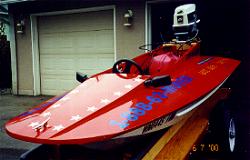
To: Glen-L
From: John C. Smith
Date/Time: 7/14/00
Subject: Photo's
Here are some updated photos and a performance report.
The boat handles very well at all speeds. The Tunnel Mite seems to thrive on choppy water, the stability of the hull is impressive. The turning is fairly flat. Top speed with a 25hp motor and a re-pitched prop is close to 40mph (probably a little faster with a lighter driver!), so far no tendency to flip over. This boat is a lot of fun. After I finish your Duckboat-Two, I think the Tunnel King could be next.
John C. Smith
What are your experiences?Boat RegistrationMichael G. McGuire wrote:
Gail,
ANSWER: The Coast Guard does not certify
plans for the home builder. The USCG has a booklet
available for "the Backyard Boatbuilder".
This will list tests and formulas for determing
capacity plates. In California, boats are registered
through the DMV. My experience has been that they
don't ask many questions. They want to see
receipts that indicate that you have paid for
materials to show you built it and didn't steal
it. They have not asked about a capacity plate. They
supply a hull identification and registration
number. These procedures vary from state to state,
so it is best to check with the local licensing
authority for their requirements. How much does it cost?
For those who have
completed a Glen-L design, how much did it cost...
how many hours to build? Example: Any additional information is welcome. Be sure to say what your cost figures include. We will start a page that lists your comments. If you do not mind being contacted, list your email address and specify that you want it posted, otherwise we will not post it. This sort of information is of real value to other builders or potential builders. If you know some of the information and not the rest, share anyway. Be sure to say what part of the world you live in. In the past we have received limited response to this type of appeal, we hope you will take the time to send in your stats to help other builders budget their project. |
Shop talk: Fiberglassing your sailboat's centerboard trunk
Fiberglass is advised for the inside of the daggerboard or centerboard trunk to protect against abrasion. This is obviously not something that can be done after assembly. Typically, a trunk will be assembled with two sides, and a spacer block at each end. One side usually has the spacer blocks attached, the other is a piece of plywood. Both halves will be covered separately with a layer of fiberglass cloth. The half without the spacer blocks is covered so that the material extends to the edges of the trunk where it is trimmed off flush. On the side with the spacer blocks, it is best to fill the inside corners with a resin putty fillet (epoxy resin plus silica) so the fiberglass will not lift and form air bubbles at the corners. Also, radius the spacer block inside corners. Apply the fiberglass to this half across the plywood, up over the spacer blocks and trim flush with the edge of the trunk side. Completely sand the fiberglass surfaces of both halves to the desired degree of smoothness, but do not apply any paint.
The trunk halves are now ready for assembly. With some centerboard trunks, provisions must be made before assembly for various centerboard components such as the centerboard pennant (the line which raises and lowers the centerboard) and the centerboard pulleys that may be a part of the pennant tackle. The trunk halves are assembled with screws being recommended for larger centerboard trunks, and with nails or screws for daggerboard trunks. The preferred glue is an epoxy resin with fillers added to form a thin putty. This putty gasket insures that no moisture will get through the junction. When the two sides are screwed together, the putty will squeeze out at the edges. Use a long dowel to scrape off inside putty and to form a fillet. If there is a leak in a sailboat, it is inevitably around the centerboard trunk.
When preparing the outside of the hull for fiberglassing, the edges leading into the trunk should be radiused. During the fiberglass process, cloth is tucked into the trunk to protect and seal the bottom planking/trunk junction; tuck in as far as practical. Sand off any burrs on the inside to prevent the centerboard or daggerboard from hanging up. We would use a coarse belt sander with a piece of one-by fitted inside.
Note: The reason for the fillets and rounded edges in the above description is that (1) fiberglass will not conform to a sharp interior corner and will tend to pull away, leaving a void. (2) If you attempt to fiberglass around a sharp exterior corner, the cloth will tend to lift on one side of the corner when smoothing the opposite side, then visa versa.
Salt water and wood
I frequently get questions about boatbuilding in which the questioner is careful to specify that it is going to be used in salt water, thinking that the boat will somehow be less durable when used in the ocean. Salt water can be death on metals, but is less a threat to wood than fresh water.
Back in the days of wooden sailing ships, salt would often be put in the hold so that any rainwater that got into the bilges would not cause dryrot. Fresh or salt water is an issue with metals, particularly if the boat will be moored in salt water, but not with wood.
Recent emails:
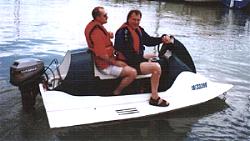
Subject: Two Additional Boat Pictures
Date: Wed, 28 Jun 2000
From:Bob Holt
Hello:
I launched my boat ( Wild Thing) last June, and sent in one
photo which wasn't the best quality. I am enclosing a
couple of JPG photos of the boat with myself on-board in one
and a friend and I in the other. I know you're busy, but
would like to show other people that your boats are FUN !!
(at least mine is !!! ).
REALLY enjoy the boat !!! It catches everyone's eye !!
Regards,
Bob Holt
Port Dover, Ontario, Canada
(Mr. Holt used a Mariner 15 hp outboard.)
Subject: Guest Book entry
Date: Thu, 6 Jul 2000
name: Norbert Chartrey
Comments: I have several boats from your plans and they have all been great to build and have performed outstandingly. While I have built a number of boats from other plans, yours are by far the best I have ever used. The boats I have built are the Sea Knight, the Ski-Tow, the 8-Ball, Tuffy, and a 14-ft drift boat (I think the plans included three different sizes.). I have also purchased plans for the Huck Finn, a dory, and a rowing dory.
Subject: RE: Glen-L Order
Date: Mon, 10 Jul 2000
From: Michael G. McGuire
Barry,
I have one other question for
you. I happened across 300 Brd./Ft. of Black walnut. Checking
the woods specifications, I found that it has all of the
properties that White Oak has, with the exception of weight
(Walnut is 20-30% lighter), all other specs are = or). I
realize it's much more expensive than White Oak, but a
bird in the hand as they say. Besides I paid $50 to get it
cut 2 years ago, it's been drying in "stickers"
for two years, and I can plane it myself for free. What is
your opinion as a frame and Bright-work lumber in boat
construction? I am considering using it to build a Tango.
Please let me know your opinion. Thanks for the help.
Mike McGuire
ANSWER: I have checked through all the reference books we have that list boatbuilding woods; none list walnut or black walnut. I am not sure what characteristics it has that makes it not desireable, could be prone to rot or not stable? Some of our builders have used it on dashes and decks and were happy with the results, but this would have been shortly after construction, don't know how it stood up. I would not use it for frames or longitudinals, unless you can find reference to it being used successfully.
PS. In the US Dept of Agriculture Wood Handbook, "Woods
that cup and tend to pull loose from fastenings when exposed
to weather"; walnut, black... Pronounced (tendency to
cup).
--
Barry
(Any comments from builders?)
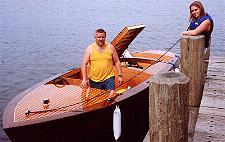
Subject: Registry update
Date: Tue, 27 Jun 2000
From: Bronkalla, Mark
Riviera / Mark Bronkalla
On the water. Lots of compliments. Top speed 46 mph. 744
hours so far
Hi Barry and Gayle,
The boat has been fun to build and I have received a lot of support from family, friends and new boat building acquaintances.
Thank you for your help in answering questions and getting the parts I needed.
We launched the boat for the first time on June 23rd on Pewaukee Lake.
The Riviera runs well as the family ski boat. Lots of room and plenty of power. It can pull a skier at only 2500-3000rpm. Top speed at this time is 46mph at 5000 rpm. The boat drives well and handling is excellent. Teal, my wife, now thinks that she is the captain and principal driver.
It is amazing how many people stop to ask about the "restoration". All are amazed when they find out it is new construction.
More (hopefully better) photos to come after this weekend.
Hopefully more people will see that building your dream is possible and within a reasonable amount of time. We started on the boat Sept. 1 (99) and it is now 95% complete. This was done in approximately 20 hours per week (less than most people spend watching TV). The major work left to do is the final upholstery. We are riding on the bench seats and boat cushions for the summer.
Best regards,
Mark Bronkalla
David L. wrote:
Another question please. I am finishing the 11 foot sailboat from your plans and have used epoxy resin on the marine plywood. I will need to paint this boat. What do i use for paint over the epoxy? I do not see paint in your supply list. Am i missing something????
ANSWER: Once the amine blush is cleaned off and it is well
sanded, any paint that will stick to a non-porous surface
will be ok. We normally sand the surface to 100 grit, prime
with a high build primer, sand to 220 or 440 grit and paint.
We normally use InterLux Brightside, but other marine paint
companies have comparable products. Brightside, like most
others, says not to paint below the waterline. If you leave
the boat in the water for more than a few days at a time, it
will blister.
You can also use industrial enamels. The Pedal-It test model
used a primer, then a latex paint (see our site NEW/On the
drawing board).
We do not sell paints because of shipping requirements.
--
Barry
Customer Service
Sunday, July 9, 2000
name: Rob Witte
Comments: Hello to everyone at Glen-L. I took my first boat ride when I was 1 year old (my Grandpa's home-made woodie) and got my first Glen-L catalog around 1960, when I was 11. I built two boats before I turned 14 and another one in my 20's which was stolen (somewhat flattering!). I grew up around Lake Minnetonka, where everyone I knew had Chris Crafts or Lymans or Higgins, etc. We had a cabin up North (of MPLS), and aluminum boats were "de rigeour", but I never lost my love of wood boats.
About three years ago I caught the "build-a-boat bug" bad, and began learning, researching, drawing and designing. After a lot of misguided effort I turned to Glen-L. When I received your boat design catalog I was already pricing tools and plywood. I flashed on some of your designs right off the bat, because, in terms of hull design or profile, they were similar to the lines I was 'drawing'. I was particularly interested in the Audeen, Miss Mist, Bonanza, and Sea Knight, all of which I bought plans for.....
I enjoy your web site and some day I WILL build another boat, but meanwhile there's a bunch of stuff I need for this one....
Friday, July 14, 2000
name: Mike Miller
Comments: I've had your catalog for 4 years. I started building my first boat last month. The "Duckboat Too". I'm having so much fun that I'm wondering why I waited so long to start. This is very relaxing and satisfying stuff, and to imagine that when I'm through, I can actually get in this thing and take a trip down a bayou or around a lake in it.
Subject: Jack Tar
Date: Fri, 14 Jul 2000
From: Bob Warner
Dear Gayle
Thank you for your
E.mail 29th June 2000, there are update photos on the way to
you, progress has been slower because of bad weather
conditions here in England. That said, the windows are now
fully glazed, so we are able to work on the interior when the
weather turns. All the decks are teak planked, and Mummy Sue
looks great. Because Jack Tar is such a traditional design, I
have approached my Monthly Magazine, Traditional Boatowner,
to maybe make an article of Jack Tars progress. We went to
the London Boatshow in January of this year, and my wife
Sue's comments were, "I will feel very safe onboard
Jack Tar, compared with the boats we boarded at the
show...". Thanks for all your help during building Jack
Tar, best wishes to you all.
Bob Warner, Herts, England
Walt was having trouble bending the chines into position on his Alpha 2...
Subject: chine bending made easey
Date: Tue, 18 Jul 2000
From: Walter Conrad
I soaked my chines in a 10' black plastic ABS pipe. After soaking one half of the chines for 2 days, I flipped them over and soaked the other end. I wrapped the exposed portion in plastic bags so they wouldn't dry out. The chines bent effortlessly. Walt
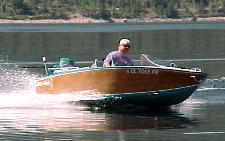
Subject: Doug Hodder Zip project
Date: Mon, 24 Jul 2000
Thanks to everyone at Glen-L for their assistance in the construction of my boat. I was thoroughly satisfied with the plans that were sent. I don't think that I had any real problems with anything that was not solvable with a phone call. To anyone who is thinking about building their own boat, you can't go wrong with these guys and their plans. They pretty much have any type of boat to suit your needs. The plans were easy to follow and very accurate. I can't wait to start my next boat. I'm a happy camper and the dog gives it 5 barks of approval. Doug and Daisy
Tuesday, July 25, 2000 at 17:01:52
------------------------------------------------------------------------
name: CHRIS MAHON
Comments: The TNT which I bought from Glen-L about two months ago with a friend is great. We are taking our time with it. We don't want it to sink the first time we take it out. However we are looking foward to the day in which we lauch the boat. Thank you Glen-L for making inexpensive and easy boats for us to build.
Build more boats
Glen-L boats, of course
